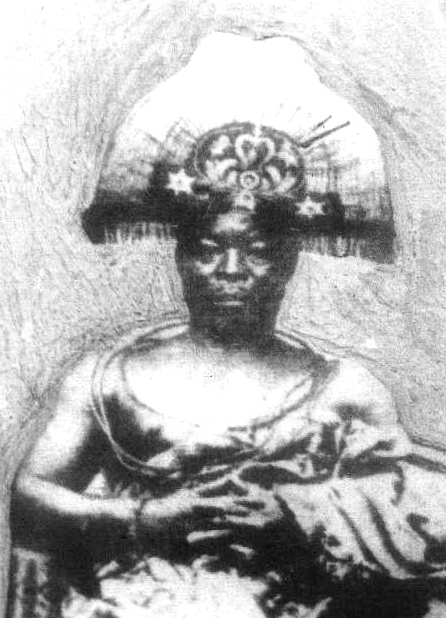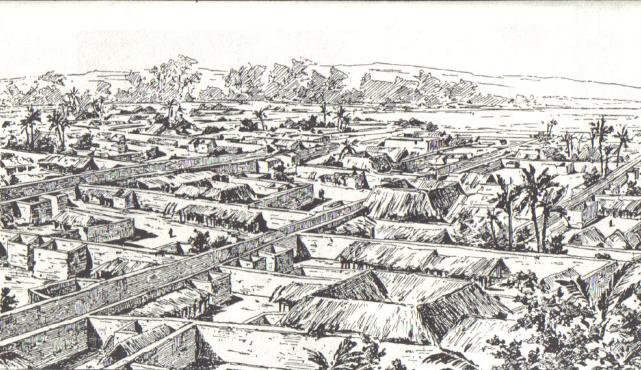|
Oguola
Oba Oguola was a ruler of the Benin Kingdom, reigning from 1280 AD to 1295 AD. His reign was marked by achievements in fortifying the city of Benin, enhancing its defenses, and contributing to the cultural and economic development of the kingdom. Born into the royal family, Oguola's ascent to the throne was prompted by the extended absence of his elder brother, Prince Obuobu, who was engaged in military campaigns. This unorthodox succession was a pragmatic decision by the kingdom's elders and advisors to ensure stability and effective leadership during a critical period. Oba Oguola's commitment to the Benin Kingdom's welfare and security was evident in his initiatives to fortify Benin City, including the construction of the first and second moats. These moats, characterised by their impressive size and strategic design, served as defensive barriers to protect the city from external threats. Furthermore, Oguola played a role in the revival of the ancient guild of brass casting i ... [...More Info...] [...Related Items...] OR: [Wikipedia] [Google] [Baidu] |
Ewedo
Ewedo, originally known as Prince Efabo, was the fourth Oba of the Kingdom of Benin who reigned from 1255 AD to 1280 AD. He was the only son and successor of Ehenmihen. He is credited with moving the seat of his government from Usama to the present palace site, introducing various gods and laws, and changing the name of the country from Ile or Ile-Ibinu to Ubini ( Benin). He also reformed the political and administrative system of the kingdom, established a palace bureaucracy, and expanded the territory and influence of Benin. Background The Kingdom of Benin was one of the oldest and most influential states in West Africa. According to oral tradition, it was founded by the Ogiso (meaning "kings of the sky" or "rulers of heaven") who ruled from a mythical city called Igodomigodo. The Ogiso dynasty lasted for about 31 generations until the last Ogiso, Owodo, was deposed by a group of elders led by Chief Odion. The elders then sent an emissary to Ife, a powerful Yoruba cit ... [...More Info...] [...Related Items...] OR: [Wikipedia] [Google] [Baidu] |
Unuamen, Nigeria
Unuamen also spelt Unuame is an ancient village community by Ovia river in Ovia North-East Local Government Area of Edo State, Nigeria. Unuame is about from Benin City and from Benin Airport. Unuame is one of the ancestral homes of Oba Esigie's maternal grandfather and home town to some group of Binis (Benin people). The people of Unuame have remained loyal to the monarch since the establishment of the ancient Kingdom of Benin. Being a part of the Kingdom of Benin, Unuame is at the heart of the tropical rainforest in the southern part of Nigeria, way to the west of the delta of the Niger River and inland from the coast. Unuame and the sub-camps within the domain it covers is strategically along the swampy terrains on the east bank of the Ovia/Osse river. In other words, the community is naturally bounded in the west by the Ovia/Osse river, the largest river in the Kingdom of Benin, and most of its economic activities revolve around it. The Ovia/Osse river flows through Unuam ... [...More Info...] [...Related Items...] OR: [Wikipedia] [Google] [Baidu] |
Udagbedo
Udagbedo was the seventh Oba (king) of the Benin Empire, ruling from around 1299 to 1334. He was the second son of Oba Oguola and the brother of Oba Edoni. Udagbedo's rule saw the expansion of the Benin Empire to the Ga region, currently part of Ghana. His reign was marked by a dispute with Agbodo, a figure who resisted the Oba's authority and attempted to violate a tradition by planning his burial in the palace precinct. Early life and ascension Udagbedo was born in Benin City, the capital of the Benin Empire. He was the second son of Oba Oguola, the fifth Oba of Benin, and the brother of Oba Edoni, the sixth Oba of Benin. After the death of his brother Edoni, Udagbedo became the seventh Oba of Benin, around 1299. He inherited a kingdom that had established trade connections with the Saharan states to the north and the Yoruba kingdoms to the west. Reign During Udagbedo's reign, agriculture and trade developed. He encouraged the cultivation of crops such as pepper, cotton, ... [...More Info...] [...Related Items...] OR: [Wikipedia] [Google] [Baidu] |
Oba Of Benin
The Oba of Benin is the traditional ruler and the custodian of the culture of the Edo people and all Edoid people. The then Kingdom of Benin (not to be confused with the modern-day and unrelated Republic of Benin, which was then known as Dahomey) has been and continues to be mostly populated by the Edo (also known as Benin ethnic group). In 1897, a British military force, of approximately 1,200 men, under the command of Sir Harry Rawson, mounted the Benin punitive Expedition. The force dispatched in retaliation to the ambush of a British party, at Ugbine village near Gwato, on the 4th January 1897, by a group of Benin soldiers, acting without orders from the Oba; the ambush had led to the deaths of all but two of the British party. The British force captured the capital of the Kingdom of Benin, sacking and burning the city while forcing the Oba of Benin, Ovonramwen, into a six-month exile. The expeditionary force consisted of both indigenous soldiers and British officers b ... [...More Info...] [...Related Items...] OR: [Wikipedia] [Google] [Baidu] |
Benin Moat
The Benin Moat (), also known as the Benin Iya, or Walls of Benin, are a series of massive earthworks encircling Benin City in Nigeria's Edo State. These moats have deep historical roots, with evidence suggesting their existence before the establishment of the Oba of Benin, Oba monarchy. Construction began around 800 AD and continued until 1460 AD, involving large-scale manual labour and the repurposing of earth from the inner ditch to build the outer berm. Some traditional sources claim that these earthworks spanned approximately , enclosing about of land, but very little remains today. The Benin Moat served as defensive structures, with Rampart (fortification), steep banks and a berm to deter invaders. Access to the city was controlled through Ancient gates of Benin Kingdom, nine gates. Today, remnants of the moats can still be found in Benin City, although Urbanization, urbanisation and Territorial dispute, land disputes pose challenges to their preservation. Recognised for ... [...More Info...] [...Related Items...] OR: [Wikipedia] [Google] [Baidu] |
Edo People
The Edo or Benin people are an Edoid ethnic group primarily found in Edo State, Southern part of Nigeria. They speak the Edo language and are the descendants of the founders of the Benin Empire. They are closely related to other ethnic groups that speak Edoid languages, such as the Esan, the Afemai, the Isoko, and the Urhobo. The name "Benin" (and "Bini") is a Portuguese corruption, ultimately from the word "Ubini", which came into use during the reign of Oba (ruler) Ewuare the Great, c. 1440. "Ubini", a word meaning Vexation, used by Prince Oranmiyan, son of the wealthy ruler of Uhe (Ife) to describe the frustration he encountered after he was invited to rule benin. ''Ubini'' was later corrupted to ''Bini'' by the mixed ethnicities living together at the centre; and further corrupted to ''Benin'' around 1485 when the Portuguese began trade relations with Oba Ewuare giving them coral beads. History Administrative region Edo people can be found in Nigeria's Edo ... [...More Info...] [...Related Items...] OR: [Wikipedia] [Google] [Baidu] |
Obas Of Benin
Obas may refer to: People * Beethova Obas (born 1964), Haitian musician * Charles Obas, Haitian painter Places * Obas District, Peru Other * OBAs, Optical Brighteing Agents {{dab, surname ... [...More Info...] [...Related Items...] OR: [Wikipedia] [Google] [Baidu] |
Oba (ruler)
Oba means ″ruler″ in the Yoruba and Bini languages of West Africa. Kings in Yorubaland, a region which is in the modern republics of Benin, Nigeria and Togo, make use of it as a pre-nominal honorific. Examples of Yoruba bearers include Oba Ogunwusi of Ile-Ife, Oba Aladelusi of Akure, and Oba Akiolu of Lagos. An example of a Bini bearer is Oba Ewuare II of Benin. The title is distinct from that of Oloye, which is itself used in like fashion by subordinate titleholders in the contemporary Yoruba chieftaincy system. Aristocratic titles among the Yoruba The Yoruba chieftaincy system can be divided into four separate ranks: royal chiefs, noble chiefs, religious chiefs and common chiefs. The royals are led by the obas, who sit at the apex of the hierarchy and serve as the fons honorum of the entire system. They are joined in the class of royal chiefs by the titled dynasts of their royal families. The three other ranks, who traditionally provide the membership of a series of ... [...More Info...] [...Related Items...] OR: [Wikipedia] [Google] [Baidu] |
Benin City
Benin City is the capital and largest city of Edo State, Nigeria. It is the fourth-largest city in Nigeria according to the 2006 census, after Lagos, Kano, and Ibadan, with a population estimate of about 3,500,000 as of 2022. It is situated approximately north of the Benin River and by road east of Lagos. Benin City is the centre of Nigeria's rubber industry, and oil production is also a significant industry. The city was the most important settlement of the Edo Kingdom of Benin, which flourished during the 13th to the 19th century. It held important trade relations with Portugal during the last centuries before being captured, sacked and burnt in 1897 by a British punitive expedition. Many bronze sculptures in Benin City palace, collectively termed the Benin Bronzes, were taken by the British who followed up their victory by gradually colonizing the area, eventually incorporating the region into Colonial Nigeria. The indigenous people of Benin City are the Edo peopl ... [...More Info...] [...Related Items...] OR: [Wikipedia] [Google] [Baidu] |
Museum Of Black Civilisations
The Museum of Black Civilisations is a national museum in Dakar, Senegal, that opened on 6 December 2018. It is directed by Hamady Bocoum, an archaeologist and researcher at Cheikh-Anta-Diop University. The museum was conceived with the goal of highlighting "Africa's contribution to the world's cultural and scientific patrimony." According to Bocoum, it is particularly important to remember that "ironworking was discovered in Africa 2500 years before Christ." The museum was on the list of "ultramodern museums" compiled by Felwine Sarr and Bénédicte Savoy in their report on the restitution of African cultural heritage ''Rapport sur la restitution du patrimoine culturel africain. Vers une nouvelle éthique relationnelle'' (en: ''The Restitution of African Cultural Heritage: Toward a New Relational Ethics'') submitted in November 2018 to the president of France. History Opened on 6 December 2018, it is the realisation of the vision of Léopold Sédar Senghor, Senegal's first P ... [...More Info...] [...Related Items...] OR: [Wikipedia] [Google] [Baidu] |




